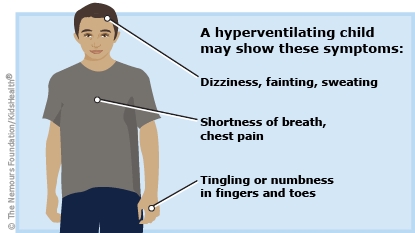After Hyperventilation: How to Care for Your Child
Hyperventilation means breathing too fast or too deeply. It can be scary for children, but it is not harmful. By learning ways to relax and control their breathing, kids can help prevent future episodes.


Our bodies need oxygen for energy. As part of the body's energy-making process, oxygen is changed to carbon dioxide. We breathe in to get oxygen and breathe out to get rid of carbon dioxide.
Normally, our lungs breathe at just the right speed to keep a good balance of oxygen and carbon dioxide in our bodies. For example, when we exercise, we need more oxygen and make more carbon dioxide, so we breathe faster.
In an episode of hyperventilation, a person breathes too fast or too deeply for what the body needs. This upsets the body's balance of oxygen and carbon dioxide. A hyperventilating child may be short of breath, sweat a lot, faint, have chest pain, have twitching in the hands or feet, be anxious, or feel tickling or tingling in the skin.
Hyperventilation is very common. Although the symptoms can be scary, they are harmless. Health care providers aren't sure what causes episodes of hyperventilation, but they often appear to be related to stress, anxiety, or panic attacks.
A health care provider usually diagnoses hyperventilation by ruling out other causes of irregular breathing.
Treatment focuses on teaching kids ways to relax and control their own breathing. In some cases, the health care provider may prescribe medicine to shorten or prevent episodes of hyperventilation.

-
If your health care provider has prescribed medicine, give it to your child as directed.
-
Encourage regular exercise and rest, which can help your child better cope with stress.
-
Teach your child to relax and control breathing, as you were directed.


Your child:

Your child: